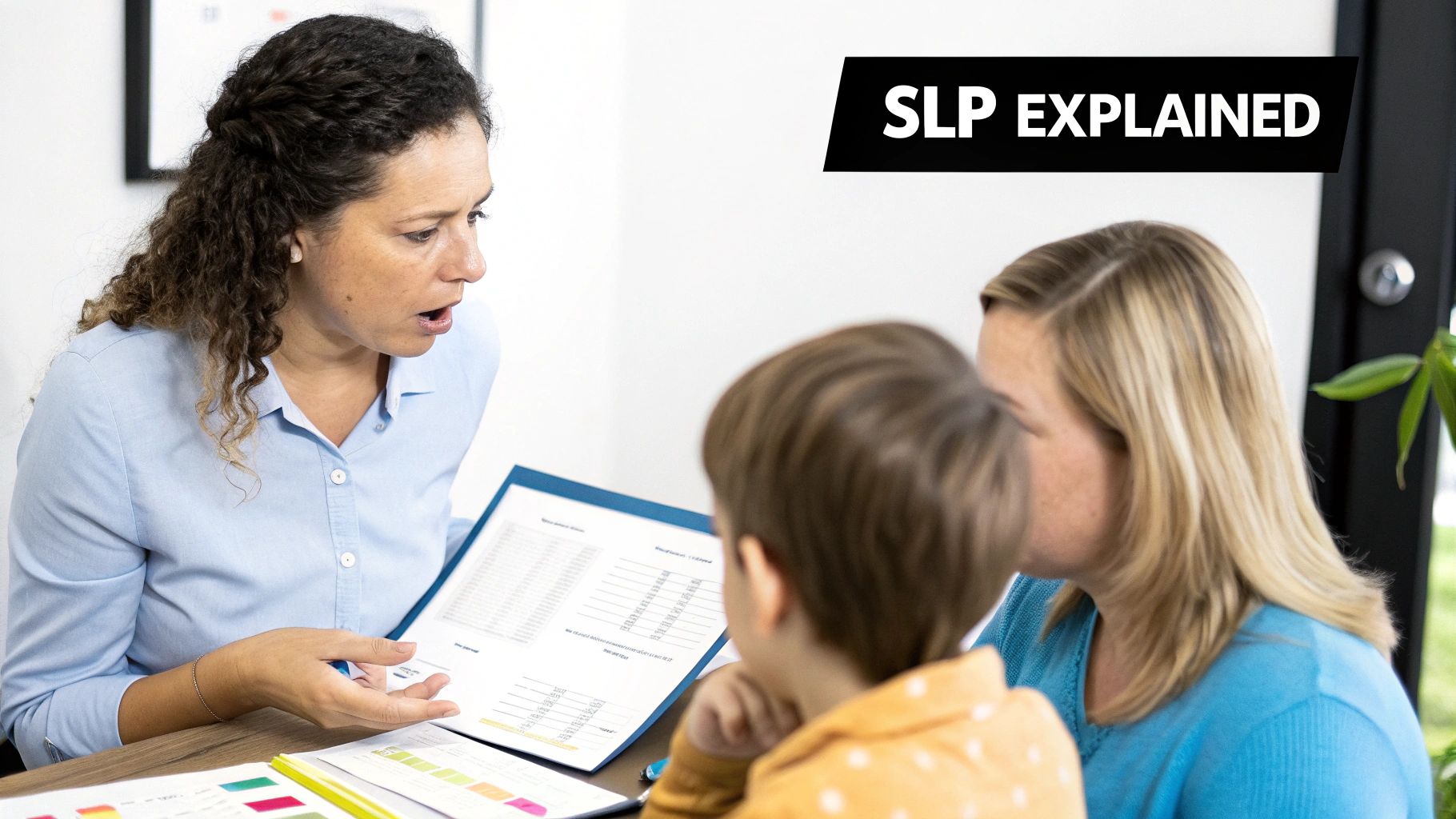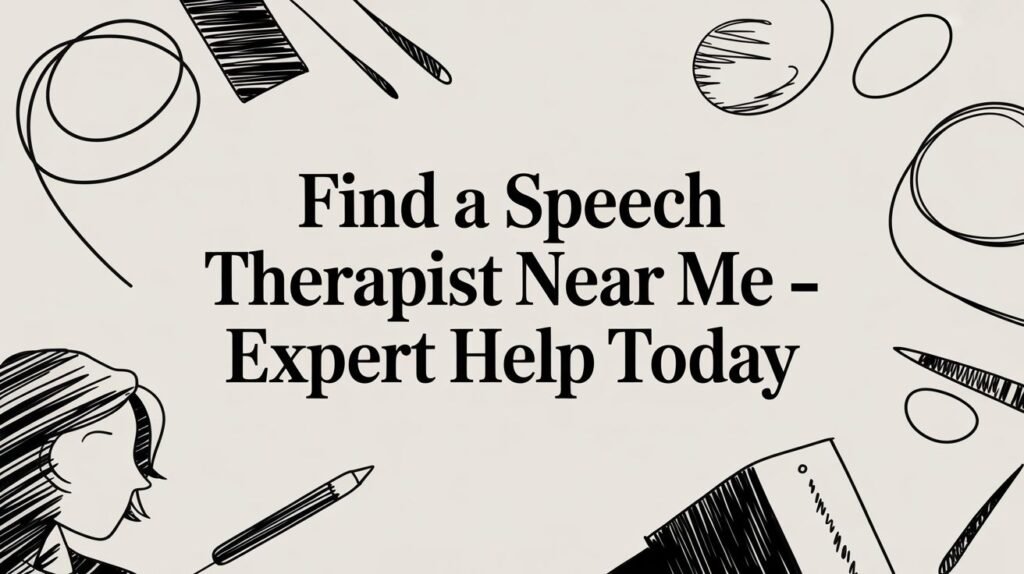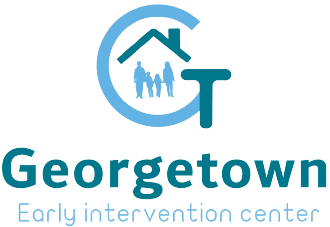When you start searching for a "speech therapist near me," you're taking the first, most important step toward unlocking clearer communication for your child. A speech-language pathologist (SLP) is a certified expert who helps people find their voice, diagnosing and treating a wide range of communication and swallowing disorders so they can connect more easily with the world around them.
Your Search for a Speech Therapist Starts Here

Starting this journey can feel like you’ve been handed a map to an unfamiliar place. You know where you want to go—better communication for your child—but the route isn't always marked. Think of an SLP as your personal guide, someone who knows the terrain inside and out and can draw a personalized path to get you there. They do more than just teach sounds; they build the very foundation for understanding, self-expression, and social connection.
The need for this kind of expert support is more common than most people think. Communication disorders affect an estimated 40 million Americans, and speech therapy is a critical part of the solution. The numbers are especially striking for children, with about 5% showing noticeable speech issues by the time they start first grade. You can learn more about these speech therapy statistics and how they impact families.
Signs It Might Be Time for a Consultation
Knowing what to look for is the key to getting help at the right time. While it’s true that every child hits milestones at their own pace, some patterns can signal that a little extra support from a speech therapist would make a big difference.
A few common signs fall into these categories:
- Pronunciation Challenges: Trouble making certain sounds (like "r" or "s") or being hard for strangers to understand.
- Vocabulary Gaps: Using noticeably fewer words than other kids their age or struggling to pick up new ones.
- Sentence Structure Issues: Relying on very short phrases or finding it hard to string words together into a full sentence.
- Social Communication Difficulties: Having a tough time with the back-and-forth of conversation, making eye contact, or reading body language.
Finding the right SLP is like finding the perfect coach. They see each player’s unique strengths and challenges and then create a game plan that helps them succeed, both on and off the field.
Looking for a local therapist is really about finding a partner—someone who can give you a clear picture of what's going on and create a supportive, individualized plan. At Georgetown, we build every plan from the ground up because we know no two children are the same. By spotting these early signs, you can take that next step with confidence.
Quick Checklist for When to See a Speech Therapist
To help you get a clearer picture, we've put together a simple checklist. This table outlines some general communication milestones and signs that might suggest it’s a good time to chat with a professional.
| Age Group | Key Communication Milestones | Signs That May Warrant a Consultation |
|---|---|---|
| 12-18 Months | – Babbles with different sounds – Responds to their name – Uses gestures like waving | – Isn't making many sounds – Doesn't respond to simple requests – Uses few or no gestures |
| 18-24 Months | – Says around 20-50 words – Starts putting two words together – Follows simple commands | – Has a vocabulary of fewer than 20 words – Doesn't combine words – Seems to have trouble understanding you |
| 2-3 Years | – Has a word for almost everything – Speaks in 2-3 word sentences – Is understood by family most of the time | – Speech is very difficult to understand – Leaves off the ends of words – Doesn't ask questions |
| 4-5 Years | – Tells stories – Uses longer, more complex sentences – Can be understood by almost everyone | – Stutters or repeats sounds frequently – Has trouble with grammar or sentence flow – Avoids talking in social situations |
Remember, this is just a guide. If you have any concerns at all, no matter your child's age, reaching out to a speech therapist for an evaluation is always a good idea. It’s the best way to get answers and peace of mind.
Understanding What a Speech Therapist Actually Does

When you start looking for a "speech therapist near me," what comes to mind? For many, it’s the classic image of someone helping a child pronounce their "r"s. While that’s definitely part of the job, the world of a speech-language pathologist (SLP) is so much bigger.
Think of an SLP as a communication detective. They’re trained to uncover the root cause of a communication challenge and then create a personalized roadmap for improvement.
Their work covers the entire spectrum of how we communicate—and even how we eat and drink. They help people of all ages, from infants who struggle with feeding to adults recovering their abilities after a stroke. It’s a field that goes far beyond simple pronunciation.
The Core Areas of Expertise
A speech therapist's work is often organized into several key domains. Each one is like a different piece of the communication puzzle they help people put together.
Articulation and Phonology: This is the area most people are familiar with. It focuses on how we physically produce speech sounds. Articulation is all about the motor skills—how we move our tongue, lips, and jaw. Phonology, on the other hand, deals with the brain's rules for how sounds fit together in a language.
Language (Receptive and Expressive): This is a big one. It covers both understanding what others are saying (receptive language) and being able to share our own thoughts and ideas (expressive language). An SLP can help build vocabulary, improve grammar, and teach how to structure sentences correctly.
Fluency: This domain is all about the rhythm and flow of speech. Therapists work with individuals who stutter, giving them strategies to manage interruptions so they can communicate more smoothly and confidently.
A speech therapist does more than just correct sounds; they rebuild the bridges of communication that connect an individual to their family, friends, and community. Their goal is to make every interaction more meaningful and less frustrating.
Beyond Basic Speech and Language
The role of an SLP doesn't stop there. It extends into highly specialized areas that can have a profound impact on daily life. When you find a qualified speech therapist, you're connecting with a professional who can support far more complex needs.
For example, after a stroke, roughly 25-40% of survivors experience a language disorder called aphasia, which can disrupt their ability to speak and understand. An SLP is absolutely essential in helping them regain those vital skills.
Here are a few other critical areas they cover:
- Cognitive-Communication: This focuses on the thinking skills tied to communication, like memory, organization, and problem-solving. It's especially important for individuals who have sustained a brain injury.
- Social Communication (Pragmatics): This involves the unwritten social rules of conversation. SLPs help people learn to take turns, understand body language, and use the right tone of voice in different situations.
- Voice and Resonance: Therapists can address issues with the quality, pitch, and volume of the voice, which might be affected by medical conditions or simple vocal strain.
- Swallowing and Feeding (Dysphagia): Many SLPs are also experts in treating swallowing disorders, helping ensure that individuals can eat and drink safely without the risk of choking.
Understanding this wide scope is key. It shows that a speech therapist is a versatile expert, ready to tackle a diverse range of challenges to improve a person's overall quality of life.
How to Choose the Right Local Therapist

Finding a local therapist is the easy part. The real work—and the part that truly matters—is finding the right one. Think of it like putting together a dedicated support team for your child. You need a professional who not only brings the right skills to the table but also genuinely connects with your family’s unique situation and goals.
This means you’ll need to go beyond a quick search for a "speech therapist near me." You'll want to dig a little deeper to understand what makes a therapist a fantastic fit, looking at their qualifications, specialized experience, and therapeutic style. It’s about finding the perfect piece for your child's puzzle.
Verify Credentials and Qualifications
Before you get into personalities and different therapy approaches, the first step is always to confirm a therapist’s professional credentials. This is your baseline assurance that they’ve met the high standards required for education and practice in their field.
The key thing to look for is the CCC-SLP designation, which stands for the Certificate of Clinical Competence in Speech-Language Pathology. Awarded by the American Speech-Language-Hearing Association (ASHA), this is the gold standard. It proves the therapist has earned a master's degree, completed a rigorous clinical fellowship, and passed a national exam.
With a projected job growth rate of 15-19% for speech-language pathologists through 2034, the demand for qualified professionals is surging. This just underscores how critical their role has become. You can learn more about the growing demand for speech therapists and why finding a certified one is so important.
A therapist's qualifications provide the foundation, but their specialised experience is what builds the bridge between their expertise and your child's specific needs.
Align Expertise with Your Child’s Needs
Speech therapy is definitely not a one-size-fits-all solution. A therapist who is incredible at helping adults recover speech after a stroke might not be the best choice for a toddler with a language delay. It’s so important to find someone whose experience truly matches up with your child's specific challenges.
When you're looking at a therapist's background, think about these things:
- Age Group: Do they mostly work with infants, school-aged kids, or adults? A pediatric specialist will be an expert in things like play-based therapy and key developmental milestones.
- Specific Conditions: If your child is dealing with something like Autism Spectrum Disorder (ASD), Childhood Apraxia of Speech, or a stutter, you’ll want a therapist who has dedicated, hands-on experience in that exact area.
- Therapeutic Approach: Don't be shy about asking about their methods. Do they make parent coaching a priority? Are there specific evidence-based programs they use? Here at Georgetown, we create individualized plans because we know every child is different, and their therapy should reflect that.
Key Questions for Your First Consultation
That initial meeting is your best chance to see if it’s a good fit. Come ready with a few questions to get a feel for their process and overall philosophy.
- How do you set and measure goals? A great therapist will work with you to set goals that are practical and meaningful for your child's life, and they'll have a clear way of tracking progress.
- What does a typical therapy session look like? This gives you a peek into their style. Is it highly structured, mostly play-based, or a blend of the two?
- How do you involve parents and caregivers? Family involvement is one of the biggest drivers of success. You’re looking for a therapist who sees you as a true partner and gives you concrete strategies to practice at home.
By taking these steps, you can feel confident in choosing a local speech therapist who is perfectly matched to help your child not just improve, but truly thrive.
What Personalized Therapy Plans Look Like
When it comes to speech therapy, a generic, one-size-fits-all approach just doesn’t cut it. Every child’s communication journey is unique, which is why an effective plan is never pulled off a shelf. It has to be custom-built from the ground up, designed to fit your child’s specific needs, personality, and daily life.
Think of it less like following a standard recipe and more like a chef creating a new dish based on the ingredients available and the diner's personal tastes.
It all starts with a comprehensive assessment. This initial step is far more than a simple test; it’s a deep dive into your child’s world. A skilled speech therapist uses a mix of standardized tests, casual observation, and in-depth conversations with you and your family. This helps them understand not just what the communication challenges are, but why they exist and how they’re impacting everyday moments.
From this rich understanding, a truly personalized roadmap begins to take shape. This plan isn't just a static list of exercises—it's a dynamic guide that evolves as your child makes progress.
Building the Therapy Roadmap
At the heart of any personalized plan are its goals. These are created collaboratively to make sure they are both meaningful and functional. A therapist might ask, "What's the one communication skill that would make the biggest difference in your child's day-to-day life right now?" The answer helps center the therapy on practical, real-world outcomes.
This process involves several key parts:
- Setting Specific Goals: Instead of a vague goal like "improve speech," a personalized plan sets a concrete target. For example, "accurately produce the /s/ sound at the beginning of words with 80% accuracy during structured activities."
- Integrating Personal Interests: If a child is obsessed with dinosaurs, the therapist will weave dinosaur-themed games and stories into the sessions. This makes therapy feel less like work and more like play, which is absolutely crucial for keeping kids engaged and ready to learn.
- Family Collaboration: The plan has to extend beyond the therapy room. The therapist gives parents and caregivers simple, clear strategies to practice at home, turning everyday moments like dinner time or a car ride into fun opportunities for growth.
A truly effective therapy plan focuses on building functional, real-world communication skills. The ultimate goal isn't just to master a sound in the therapy room, but to confidently order an ice cream cone or share a story with a friend.
A Look at an Individualized Plan in Action
Let’s imagine a four-year-old named Leo who struggles to form sentences and gets frustrated when his parents can’t understand him. His personalized plan wouldn't just focus on grammar drills. Instead, it would be a vibrant, multi-faceted approach.
His plan might look something like this:
- Play-Based Activities: Using his favorite toy trains, the therapist guides Leo to create two-word phrases like "blue train" and "go fast," naturally building his sentence structure in a context he loves.
- Storytelling with Picture Books: They might read a book together, with the therapist modeling simple sentences about the pictures and encouraging Leo to do the same. This builds both his language and early literacy skills at the same time.
- Home Practice Strategy: The therapist gives Leo's parents a specific goal for the week: focus on narrating their actions during bath time using short sentences, like "Wash hands" or "More bubbles."
This approach ensures that every part of Leo's therapy is relevant to his world. When you are searching for a "speech therapist near me," look for a professional who prioritizes this kind of thoughtful, tailored planning. At Georgetown, we believe this is the only way to build lasting communication skills and empower every child to find their voice.
Comparing Teletherapy and In-Person Sessions

The search for a "speech therapist near me" used to mean finding the closest physical office. Today, families have two incredible paths to choose from: traditional in-person sessions and modern, convenient teletherapy. Each route offers its own set of advantages, and the right choice really boils down to your family’s unique needs, lifestyle, and your child's specific goals.
Think of it like deciding between working out at a gym versus using a personal training app at home. The gym gives you direct, hands-on guidance with specialized equipment right there. On the other hand, the app offers amazing flexibility and fits perfectly into a packed schedule. Both can lead to fantastic results; they just cater to different preferences.
This shift toward virtual care is a huge reason for the growth in speech therapy services. Teletherapy has opened doors for so many, especially for families in more remote areas or those juggling impossible schedules. You can learn more about the rise of virtual speech therapy and its impact on the market.
To help you decide what might work best, let's break down the key differences between these two powerful options.
Teletherapy vs In-Person Speech Therapy Comparison
| Feature | In-Person Therapy | Teletherapy |
|---|---|---|
| Interaction | Direct, face-to-face with hands-on guidance. | Virtual, screen-to-screen using video platforms. |
| Environment | A structured, controlled clinic setting. | The comfort and familiarity of your own home. |
| Convenience | Requires travel to and from the clinic. | No travel time; sessions from anywhere with internet. |
| Engagement Tools | Physical toys, games, and therapeutic materials. | Digital games, interactive whiteboards, and online resources. |
| Parent Involvement | Parents may wait outside or observe from a distance. | Parents can easily observe and participate directly. |
| Best For | Children who need physical cues or have complex sensory needs. | Tech-savvy kids, busy families, and those in remote areas. |
Ultimately, both approaches are designed to deliver exceptional, evidence-based care. The best fit truly depends on the individual child and family circumstances.
Key Factors for In-Person Therapy
For many families, traditional in-person therapy is still the gold standard, and for good reason. That direct, face-to-face connection can be invaluable, particularly for younger children or those with more complex needs who thrive on hands-on guidance.
Here are a few of the standout benefits of in-person sessions:
- Hands-On Adjustments: A therapist can physically guide a child's mouth to shape a sound correctly or use tangible toys and tools to keep them focused and engaged.
- Fewer Distractions: A dedicated therapy room is a controlled space, specifically designed to minimize outside noise and interruptions, helping your child stay on task.
- Building Rapport: For some children, it's simply easier to build a strong, trusting relationship in person, which can be a huge motivator for making progress.
The greatest strength of in-person therapy lies in its tangible nature. The shared physical space allows for immediate, hands-on feedback and a level of interaction that can be crucial for certain therapeutic techniques.
The Rise of Teletherapy
Teletherapy uses secure, easy-to-use video conferencing to bring high-quality speech therapy right into your home. This model delivers incredible flexibility and opens up access to top specialists who might be miles away.
The biggest draw is pure convenience—no commuting, no waiting rooms, and sessions held in a familiar environment where a child often feels most comfortable and secure. It also empowers parents, making it much easier to watch sessions, understand the techniques, and learn strategies you can use all day long.
At Georgetown, we proudly embrace both models. Our goal is to ensure every child gets access to the best possible care, whether that's in our center or from the comfort of their own home.
Common Questions About Starting Speech Therapy
Taking that first step into speech therapy can feel like venturing into the unknown, and it's completely normal to have questions. You might be wondering about the process, what to expect from the sessions, and how it all comes together for your child. Getting a handle on the answers now can make you feel much more prepared and confident as you start this journey.
We’ve put together some of the most common questions families ask when they start searching for a "speech therapist near me." Our goal is to give you clear, straightforward answers that demystify the process and show you how we at Georgetown approach every child’s unique path to success.
How Long Does Someone Typically Need Speech Therapy?
This is easily one of the first questions on every parent's mind. The most honest answer? It truly varies. There's no magic number or one-size-fits-all timeline for speech therapy. The duration really comes down to the individual child and a few key factors that shape their therapeutic journey.
A good analogy is personal training. Someone training for a marathon has a very different, and much longer, plan than someone who just wants to improve their stamina for a weekend hike. Both goals are valid, but they demand different levels of time and commitment.
Several things influence how long therapy might take:
- The Specific Challenge: Correcting a single speech sound, like a lisp, might only take a few months. On the other hand, supporting a child with a more complex condition like Childhood Apraxia of Speech or significant language delays will naturally require a longer-term plan.
- Consistency and Frequency: Showing up for sessions regularly and, just as importantly, practicing at home are huge drivers of progress. Consistent effort almost always leads to faster, more lasting results.
- Individual Progress: Every child learns and grows at their own pace. A great therapist constantly tracks progress and fine-tunes the therapy plan—and the timeline—to match.
The goal of speech therapy isn't to keep a child in therapy forever. It's to give them the tools and skills they need to communicate confidently in their everyday lives, and then to celebrate as they start using them successfully on their own.
What Is the Difference Between School and Private Therapy?
Understanding the difference between school-based and private speech therapy is key to making sure your child gets the most comprehensive support possible. While both are staffed by qualified Speech-Language Pathologists (SLPs), they operate with different goals and within different frameworks.
School-based therapy is provided through the public education system. Its focus is tied directly to a child's academic success. The main goal is to address communication challenges that are getting in the way of their ability to learn in the classroom. These goals are all laid out in an Individualized Education Program (IEP).
Private therapy, like the services here at Georgetown, operates outside the school system. This gives us a much broader scope. A private therapist can address communication goals that go beyond the classroom, like improving social skills at home, working on feeding and swallowing issues, or providing more intensive, specialized interventions. Many families find that private therapy is the perfect complement to the support their child gets at school, creating a well-rounded and powerful team.
How Can I Support My Loved One At Home?
Family involvement is the single most powerful way to accelerate progress in speech therapy. The skills a child learns in a session are just the beginning. The real magic happens when those skills are practiced and reinforced in the natural, everyday environment of your home.
Don't worry, you don't need to become a therapist yourself! The best support you can give is to be an active, enthusiastic partner in the process. Think of your therapist as your coach—they’ll give you a clear, simple playbook of strategies to use.
Here are a few practical ways you can make a huge impact:
- Integrate Practice into Daily Routines: Turn car rides, mealtimes, or bath time into fun, low-pressure practice. Simply narrating what you’re doing or playing simple word games can reinforce skills without ever feeling like a chore.
- Model and Encourage: Be a great communication model. Use clear speech, wait patiently for your child to find their words, and celebrate every small win with plenty of positive reinforcement.
- Stay Connected with Your Therapist: Keep the lines of communication wide open. Ask for specific activities you can do, share your successes and challenges from the week, and work together to adjust strategies as your child grows.
When you're searching for a speech therapist near me, make sure you find a professional who sees you as an essential part of the team.
Article created using Outrank







